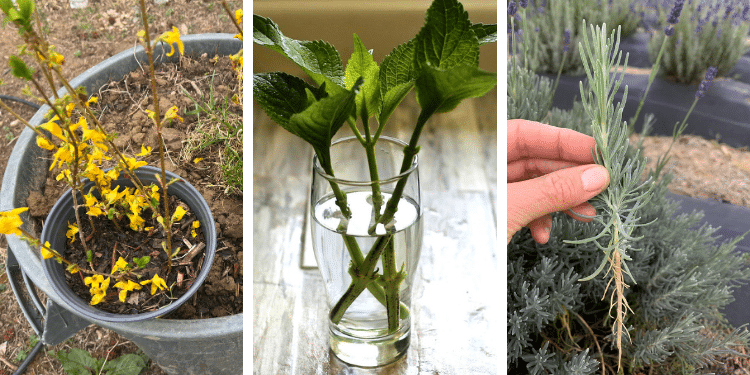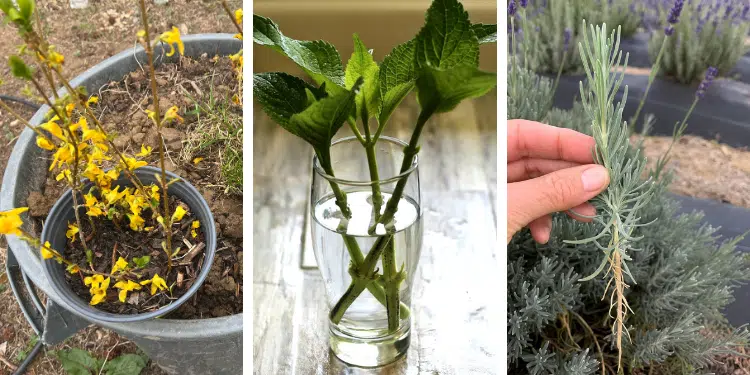Fall may feel like a time when your garden is winding down – but it’s actually one of the best seasons to start new life.
When temperatures cool and soil stays slightly warm, many plants shift their focus underground, channeling energy into strong root growth instead of leaves or flowers.
That’s why autumn is perfect for propagating plants from cuttings – especially woody shrubs, vines, herbs, and a few flowering favorites.
Why Fall Is Perfect for Plant Propagation
During early to mid-fall, plants enjoy a stress-free period – warm enough for roots to grow, yet cool enough to avoid heat stress. The soil holds moisture longer, the air is mild, and pests are fewer.
This combination creates an ideal environment for cuttings to establish strong roots before winter dormancy.
By the time spring arrives, these fall-rooted plants will already have a head start – stronger, fuller, and ready to thrive.
Best Plants to Grow from Cuttings in Fall
Woody Shrubs and Vines
1. Forsythia (Forsythia suspensa)
The golden-yellow blooms of forsythia are among the first signs of spring – bright, cheerful, and full of life. This fast-growing shrub also makes an excellent natural hedge or border, adding both privacy and color to your garden.
How to Propagate: Take 6–8-inch hardwood cuttings from the current year’s growth. Remove the lower leaves, dip the base in rooting hormone, and plant in a pot with well-drained soil. Keep consistently moist.
Why Fall Works Best: Forsythia naturally enters dormancy in autumn, directing energy into root formation. The cool, moist soil of fall encourages fast root development.
2. Boxwood (Buxus spp.)
Boxwoods are timeless evergreens – elegant, hardy, and easy to shape into hedges or topiaries. Their dense foliage makes them ideal for formal gardens or decorative pots.
How to Propagate: Take 4–6-inch semi-hardwood cuttings. Strip off the bottom leaves, dip in rooting hormone, and plant in sandy, well-draining soil. Water gently.
Why Fall Works Best: Cool air and frequent autumn rainfall encourage faster root growth. With fewer pests and diseases around, your new cuttings will establish safely.
3. Honeysuckle (Lonicera × heckrottii)
With its fragrant, trumpet-shaped flowers and vigorous vines, honeysuckle adds both beauty and wildlife appeal – hummingbirds and butterflies love it.
How to Propagate: Cut a 6–8-inch section from healthy stems, remove the lower leaves, and insert into a pot of moist, well-draining soil. Cover with a clear plastic dome or bag to maintain humidity.
Why Fall Works Best: Gentle sunlight and cool air reduce transplant stress. Autumn’s consistent soil moisture supports strong, early rooting.
4. Hydrangea (Hydrangea spp.)
Hydrangeas are garden classics, beloved for their huge, soft blooms and rustic, woody stems. Nearly all varieties root well from fall cuttings.
How to Propagate: Choose a semi-hardwood cutting 4–6 inches long. Remove all but the top leaves, dip in rooting hormone, and plant in a moist, well-draining mix. Cover lightly with plastic to retain humidity.
Why Fall Works Best: The soil is still warm enough to encourage rooting, while the plant’s slowed growth allows energy to go directly into root formation.
5. Geranium (Pelargonium spp.)
Geraniums are a gardener’s favorite for their colorful blooms and fragrant foliage – and they’re surprisingly easy to clone before winter.
How to Propagate: Take a cutting just below a leaf node and remove the lower leaves, leaving two or three at the top. Let the cut end dry for a few hours to prevent rot, then plant in lightly moist soil and cover with plastic for humidity.
Why Fall Works Best: In frost-free areas, geraniums root quickly and grow steadily through winter, providing lush blooms by spring.
6. Star Jasmine (Trachelospermum jasminoides)
Star jasmine fills gardens with glossy foliage and intoxicating fragrance. This evergreen vine thrives in sunlight and is a staple in warm, Mediterranean-style gardens.
How to Propagate: Take 4–6-inch cuttings from new, healthy shoots. Remove the lower leaves, plant in well-drained soil, and cover with a plastic bag to maintain humidity.
Why Fall Works Best: Autumn’s consistent rainfall and mild temperatures keep the soil moist, which is ideal for steady root development.
7. Butterfly Bush (Buddleja spp.)
Loved by pollinators, butterfly bush produces long, nectar-rich flower clusters that attract butterflies and hummingbirds all season long.
How to Propagate: Cut 6-inch non-flowering stems, remove lower leaves, dip in rooting hormone, and plant in well-draining potting mix. Water lightly and cover with plastic for humidity.
Why Fall Works Best: Rooting in fall allows butterfly bush cuttings to establish deep roots before winter, ensuring strong growth and earlier blooms next spring.
Softwood Plants
8. Coleus (Solenostemon scutellarioides)
Coleus is a gardener’s dream for adding color – its patterned, vibrant leaves brighten shady corners and containers.
How to Propagate: Snip 3–4-inch cuttings below a node, remove the lower leaves, and place in moist, well-draining soil. You can also root coleus in water before planting.
Why Fall Works Best: Cooler air prevents leaf scorch, and indoor propagation during fall ensures your coleus stays colorful all year long.
9. Impatiens (Impatiens balsamina)
Perfect for shaded gardens, impatiens burst with color where few other plants thrive. Their compact growth and variety of shades make them great for pots and borders.
How to Propagate: Take 3–4-inch tip cuttings from healthy stems. Root them in moist soil or a glass of water. Once roots appear, transplant into well-drained potting mix.
Why Fall Works Best: Cooler weather reduces evaporation and keeps soil evenly moist – ideal conditions for soft cuttings to root successfully.
Herbs
10. Rosemary (Salvia rosmarinus)
Fragrant, hardy, and delicious – rosemary is one of the easiest herbs to propagate from cuttings. Fall is an excellent time to start new plants if you live in a mild climate.
How to Propagate: Take 4–6-inch tip cuttings, strip the lower leaves, dip in rooting hormone, and plant in sandy, well-draining soil. Keep in a warm, bright spot.
Why Fall Works Best: Cooler weather helps rosemary conserve moisture and focus on root development, particularly in USDA Zones 9–11.
11. Mint (Mentha spp.)
Mint grows fast, smells amazing, and enhances everything from teas to desserts. It also happens to root almost instantly from cuttings.
How to Propagate: Cut several 4-inch stems, remove the lower leaves, and place in damp soil or water. Once roots form, pot them up and enjoy fresh mint all winter.
Why Fall Works Best: Mint thrives even in cooler weather, and fewer pests make fall propagation smooth and nearly foolproof.
12. Lavender (Lavandula spp.)
Lavender’s silvery foliage and soothing scent make it a must-have in any garden. It also propagates beautifully in fall’s gentle climate.
How to Propagate: Take 4–6-inch cuttings from healthy, non-flowering stems. Remove lower leaves, dip in rooting hormone, and plant in sandy, well-drained soil. Water lightly and provide bright but indirect light.
Why Fall Works Best: The moderate temperatures and stable humidity help cuttings root deeply without drying out. By spring, you’ll have established lavender ready for transplanting.
Ornamental Grasses
13. Pampas Grass (Cortaderia selloana)
Known for its tall, feathery plumes, pampas grass brings height, texture, and elegance to landscapes. It’s ideal for creating natural privacy screens or accent borders.
How to Propagate: Instead of stem cuttings, divide healthy clumps of established pampas grass. Plant divisions at the same depth as before, water thoroughly, and keep the soil moist until settled.
Why Fall Works Best: Cool temperatures and moist air help roots establish quickly before winter. Lower sunlight intensity reduces stress on young divisions.
Pro Tips for Successful Fall Propagation
- Use clean tools: Always sterilize pruning shears to avoid spreading disease.
- Choose the right medium: A mix of sand, perlite, and peat moss keeps roots aerated and prevents rot.
- Keep humidity high: Use clear plastic covers or mini-greenhouses to trap moisture.
- Water sparingly: Overwatering can drown tender cuttings – keep soil lightly damp.
- Label your cuttings: Use tags so you know which variety is which come spring.
Fall propagation is one of gardening’s best-kept secrets. While the rest of the garden slows down, your new cuttings quietly take root – preparing to explode with growth when spring returns.





